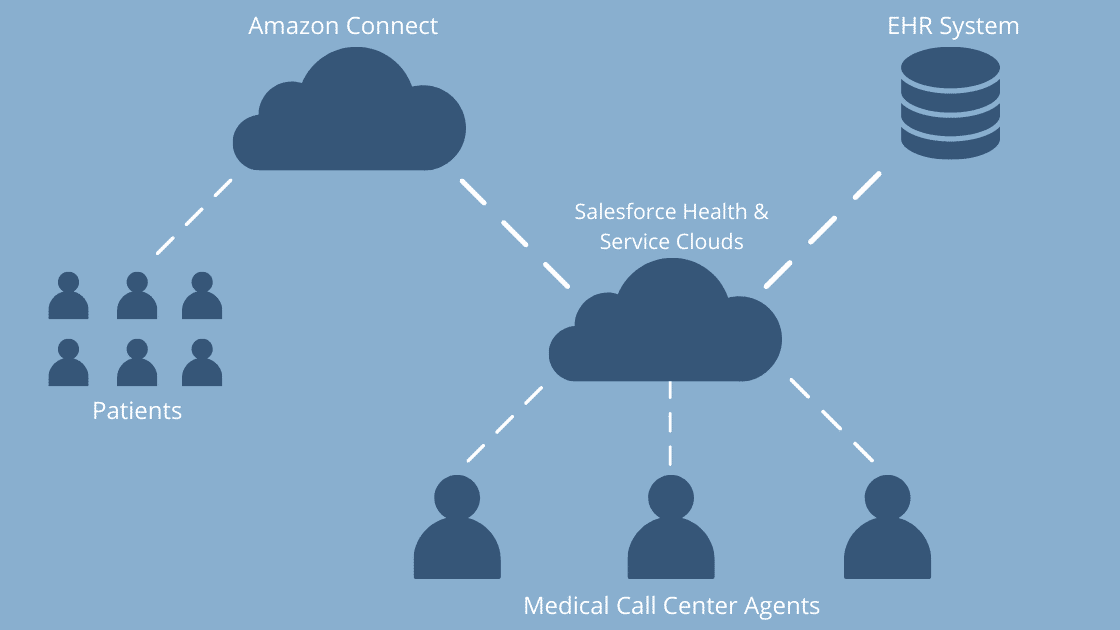Almost a decade ago, Marc Andreessen famously wrote about “why software is eating the world.” At the time, Andreessen noted that while many industries had already experienced a software-based transformation, such was yet to come in healthcare.
Until recently, a full range of medical call center functionality required cobbling together products from a variety of vendors. This meant large up-front investments in hardware and software along with lengthy implementation cycles.
Now, however, there is a suite of enterprise-grade contact center components available to small call centers—including centers with as few as five customer service representatives.
Today’s Improved Call Center
Easily configurable off-the-shelf cloud software has made it faster and cheaper to stand up a cutting-edge call center than ever before.
The benefits of deploying a cloud-based call center include:
- No more large, upfront investments
- Shorter system deployment times
- Lower ongoing costs
Here are three interconnected software components that can result in digital transformation for medical call centers.
1. Amazon Connect
If you manage a medical call center, you may already be using Amazon Connect. Or at the least, you’ve heard of it.
When Amazon couldn’t find the right voice and chat communication system with its customers, the company built its own contact center software.
As was the case with Amazon Web Services (AWS), the infrastructure that Amazon originally created for itself evolved into a product offering.
With Amazon Connect, the voice and chat components for a small contact center can be set up in days, not weeks.

2. Salesforce Health Cloud
Salesforce is a pioneer in the cloud software space. In 1999, the company started what became an ongoing disruption of expensive on-premises software and systems of all types.
Despite its name, Salesforce was only a sales-focused product in the early years. It ultimately evolved into a cloud platform for managing relationships in any industry, including healthcare.
Today, health systems and clinics have been adopting Salesforce’s Health Cloud in ever greater numbers.
Within medical call centers that have adopted Salesforce, it’s common to see two Salesforce branded feature sets in the same agent interface—Health Cloud and Service Cloud. The Service Cloud component is an agent’s main screen for fielding patient calls, answering questions, and resolving issues.
Until recently, Service Cloud was like many other contact center solutions—the voice communication component was a separate, third-party application. However, Salesforce decided to closely couple Service Cloud with Amazon Connect.
Branded Service Cloud Voice, Health Cloud is now seamlessly pre-integrated with Amazon Connect.
3. The HL7 FHIR Standard
Interoperability in healthcare has been simplified with the ongoing progression of FHIR standards.
Normative FHIR standards, such as the Patient Resource, have made it much easier to connect contact center software to EHRs. In addition, with EHRs like AllScripts moving to the cloud, interoperability setup has been further simplified.
Ideally, a medical call center agent should work in a single, browser-based application. When EHR and other clinical data are connected to Health Cloud, an agent no longer needs to toggle among multiple applications.
Rapid Technology Deployment
The initial deployment of these components can be accomplished quickly compared to what it took with legacy components. Additionally, functionality can be added incrementally once the foundation is in place.
While the following lists are not comprehensive, they summarize the types of tasks that a given call center needs to accomplish. Aside from desktop (computer, headset) and network hardware (switch, routers), everything else is software.
Voice Software Deployment (Amazon Connect)
Once the following areas are defined, Amazon Connect for a small call center can be configured in a matter of days:
- Inbound phone call flows
- Outbound phone call flows
- Users
- Prompts
- Queues
- Hours of operation
- Routing profiles
- Local or toll-free numbers to be claimed
Deployment of Medical Call Center Software (Salesforce Service Cloud)
Once items such as the following are defined, the initial Salesforce setup for a small team can be accomplished in short order as well:
- Users
- Profiles (permissions)
- Queues
- Flows (call scripts)
- Custom fields
- Picklist (drop-down) values
- Screen layouts
Integrate Amazon Connect and Salesforce Service Cloud
In combination, these two are dubbed “Service Cloud Voice.”
What’s required:
- Install a managed package in Salesforce
- Deploy an Amazon Web Services (AWS) Serverless application
- Configure the integration
Integrate Patient Data from EHR with Salesforce
The steps for connecting Salesforce to an FHIR-enabled EHR are as follows:
- Install the FHIR Native Gateway managed package
- Add the EHR endpoint information and credentials in Salesforce
- Complete EHR side configurations
This video demonstrates how you can connect Health Cloud to an EHR system in under 10 minutes.
The availability of interconnected software from major vendors makes digital transformation possible for any sized medical call center.



